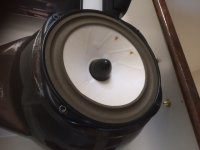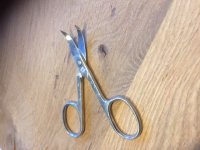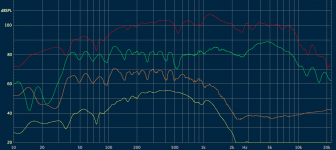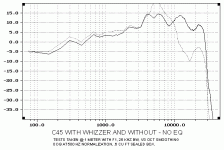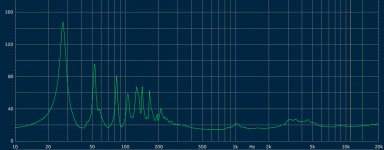8NMB420 vs DX4
Measure fresh out of the box...I expect the QTS will get downto spec value after some hours of playing:
MANUFACTURER: 18 MODEL: 8NMB420 Fs 66.65 Hz Re 5.20 Ω Sd 220.0000 cm² Qms 2.98 Qes 0.48 Qts 0.41 Cms 0.3670 mm/N Mms 15.5373 g Rms 2.18 Ωm Bl 8.44 N/A dBspl 93.91 VAS 24.8029 L Zmin 6.03 Ω L1kHz 0.40 mH L10kHz 0.29 mH
Next I made an interfacing wooden rim so that the 8NMB could be mounted in the DX4 spot.
Measure fresh out of the box...I expect the QTS will get downto spec value after some hours of playing:
MANUFACTURER: 18 MODEL: 8NMB420 Fs 66.65 Hz Re 5.20 Ω Sd 220.0000 cm² Qms 2.98 Qes 0.48 Qts 0.41 Cms 0.3670 mm/N Mms 15.5373 g Rms 2.18 Ωm Bl 8.44 N/A dBspl 93.91 VAS 24.8029 L Zmin 6.03 Ω L1kHz 0.40 mH L10kHz 0.29 mH
Next I made an interfacing wooden rim so that the 8NMB could be mounted in the DX4 spot.
The curves with the DX4 having the 3rd order LP and the 18 without any filter. The latter was the choice since it had a very nice flat part between 100Hz and 1kHz (close measurement), but it dipped measured at 1.5-2m. Without filter it was as flat as could be, but it did slightly affect the part after the 1kHz as expected. Overall not bad at all. Flatter than the Lowther but it seemed the lowther arch was a benefit for the overall curve. Efficiency seemed comparable.
Good to see both showed the room influence, especially the 130Hz peak (if I find a way to tackly this one I got it made! ;-) )
Good to see both showed the room influence, especially the 130Hz peak (if I find a way to tackly this one I got it made! ;-) )
Attachments
For a start I came to the conclusion I needed. In the frequency band I am using the driver (BLH + front firing till 700Hz) the curve remains as is...and most important the whizzer does not get "excited" by frequencies in the Whizzer range generated by the mid horn. Difference is a cleaner sound where previously in some recordings I could hear extra fuzz. I will measure a full curve without filter.
About twice as loud at 5-6kHz (which already had plenty of sizzle), and half as loud above 10kHz, ouch.I dug up my own curve for a C45 with and without whizzer. The dotted
response is without.
Too bad it's harder to replace a whizzer than cut it off, interesting to see the effect!
Similar overall result to what I saw with my de-whizzered Coral driver - in my case the response from 2.5Khz to 6Khz increased by about 3dB with the whizzer removed (although remained fairly flat, not with a peak as shown here) but at the expense that the driver started beaming badly in this frequency range - on axis response increased but off axis response reduced by even more!I dug up my own curve for a C45 with and without whizzer. The dotted
response is without.
The response fell like a rock above 6Khz without the whizzer. So my conclusion was that above 6Khz on my driver the whizzer cone is responsible for most of the output (with help from the dustcap above 10Khz) and in the 2.5 - 6Khz range the whizzer acted mainly to increase the dispersion, by increasing off axis response and actually reducing on axis response.
I found peaks and especially dips in the 2-5Khz range were mainly a result of constructive and destructive interference between the whizzer cone and the main cone due to main cone resonances causing rapid phase shifts.
Flattening the frequency and phase response of the main cone by adding appropriate damping near the edges also had the result of minimising destructive interference between the two cones by improving phase tracking between them across their overlap region from about 2Khz to 6Khz.
I'm sure there are drivers where the whizzer cone itself has bad resonances (probably more common than not) but in my Coral drivers I found the whizzer cones to be almost free of resonances and that it was almost entirely the fault of the main cone edge, and that the whizzer only made it seem worse due to the phase interactions between the two.
The physical offset between the two cones in the Z axis has a profound effect on the summed frequency response due to the change in phase shift between them - on different Coral drivers of mine where the whizzer cone offset is such that it sticks out more the response is a lot more peaky, on ones where the whizzer is a bit further back the response is smoother and without any deep notches. So the Z axis positioning of the whizzer cone seems to be very critical for smoothest response as well. A 5 mm shift is the difference between a poor result and a great result, unfortunately not much can be done to adjust it as it is set during manufacture.
Last edited:
Here's the time Troels Gravesen removed the whizzer on a Philips 9710.
Philips 9710/
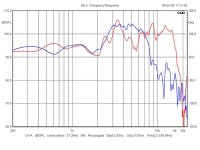
Here again, the removal pretty much killed all output above 6-7kHz, but "fixed" what is likely a phase issue with the main cone in the octave below.
I'm pretty certain I removed a whizzer on a cheap 5" FR driver some 10 years back, but did not have measuring equipment then.
Philips 9710/

Here again, the removal pretty much killed all output above 6-7kHz, but "fixed" what is likely a phase issue with the main cone in the octave below.
I'm pretty certain I removed a whizzer on a cheap 5" FR driver some 10 years back, but did not have measuring equipment then.
Last edited:
Sounds like a good application. Hopefully the change in curve above 700Hz will not make it any harder to LP the response. I know one or two people have used de-whizzered lowthers in big front-horns with success.In the frequency band I am using the driver (BLH + front firing till 700Hz) the curve remains as is...
Yes, the problem with that driver is phase cancellation between the two cones. The output of the main de-whizzered cone looks pretty smooth from 2-10Khz, while the whizzer seems to have resonances.Here's the time Troels Gravesen removed the whizzer on a Philips 9710.
Philips 9710/
View attachment 668912
Here again, the removal pretty much killed all output above 6-7kHz, but "fixed" what is likely a phase issue with the main cone in the octave below.
If you look at a picture of the 9710's them they have conical whizzers which IMHO are more prone to resonance problems than the exponential whizzers used on the Coral drivers.
Also the whizzer cone is really close to the main cone compared to the whizzers on a coral which are quite a bit further away:
9710:

Coral Flat8:

Notice the Coral whizzer as well as being curved is displaced a lot further forward than the one on the Philips driver and this offset has no doubt been carefully optimised to get the best phase tracking between the two cones and avoid cancellation.
It may have been possible to solve that phase shift issue on the Philips driver by displacing the whizzer cone further forward, but for best results a new exponential whizzer would perform better.
An exponentially tapered whizzer cone doesn't need a fold at the end - it is already far stiffer than a conical whizzer for the same weight. This is because a complex curve is inherently stiffer than a cone which is only curved in one dimension but weak in the dimension where it is straight.
Pretty sure that Dad had some 9710's kicking around but that was before I got an interest in speakers so I don't remember what they sounded like.
Pretty sure that Dad had some 9710's kicking around but that was before I got an interest in speakers so I don't remember what they sounded like.
- Status
- This old topic is closed. If you want to reopen this topic, contact a moderator using the "Report Post" button.
- Home
- Loudspeakers
- Full Range
- Did anyone have the guts to cut out a Lowther Whizzer Cone?

